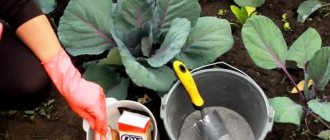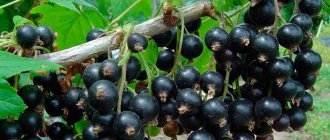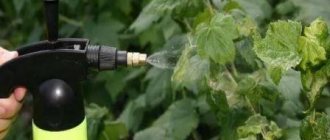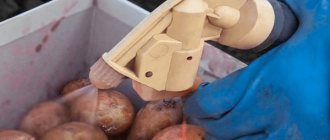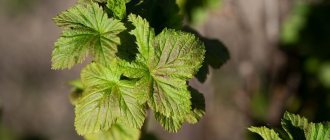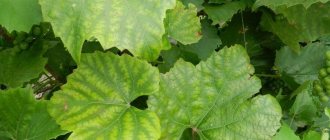An important measure for caring for tomatoes in a greenhouse and open ground is spraying the crop with nutrient solutions. Foliar feeding of tomatoes helps in treating seedlings from infectious and fungal diseases, enhances plant vegetation, and contributes to obtaining a large and high-quality harvest. In addition, foliar sprays can quickly revive plants in the event of an acute shortage of micronutrients.
How to protect tomatoes from diseases and pests
Even if tomato seeds have been pre-treated against most diseases, this does not mean that tomato seedlings or bushes will remain strong and healthy throughout the season.
Tomatoes can be affected by diseases caused by fungi, bacteria or viruses. This happens most often because vegetable growers do not follow the rules for caring for seedlings and adult plants and constantly plant tomatoes in the same places without following the rules of crop rotation. Also, much depends on the location of the beds, as well as on weather conditions in a particular summer season. The most common diseases that can affect tomatoes are fungal diseases.
Preparations for tomato diseases
The struggle for a high yield of tomatoes begins with the prevention of diseases and pests, proper care of seedlings and young plants. To improve plant growth and increase disease resistance, it is necessary to use potassium and sodium humates, growth and fruiting stimulants.
Potassium humate
Available in the form of an aqueous solution.
- It is diluted at the rate of 10 ml per 1 bucket of water.
- Plants are sprayed during the budding phase and at the beginning of flowering.
The drug increases productivity. Activates beneficial soil microorganisms.
Sodium humate
Improves plant development, reduces ovary fall.
- The contents of the package are infused in 3 liters of hot water for 8-10 hours, and then the resulting concentrate is diluted in a ratio of 1:10.
- Water the soil around the plants with this solution.
Epin
Increases the immunity of tomatoes, increases the number of ovaries and increases yield by 30%, reduces the content of heavy metals and nitrates in plants. This product is environmentally friendly, since its base is contained in the plants themselves.
- The method of application is simple: 1 ml (ampoule) of “Epin” is diluted in 5 liters of water.
- Spray the plants during budding and the beginning of flowering of the first cluster.
Stimulating the growth and development of seedlings can reduce the incidence of diseases in tomatoes, but it is rarely possible to completely avoid the disease. Then drugs with therapeutic and preventive effects come to the aid of gardeners.
| ADVICE For safe prevention and destruction of tomato pathogens, use FAS sulfur bomb. Will get rid of bacterial infections, mold, insect pests and mites in greenhouses with tomatoes. |
____________________________________________________________________
Excellent disease-resistant varieties of two-color tomatoes
Photo: FAS sulfur block for treating greenhouses and preventing late blight
What to spray after rain
If you need to restore tomato seedlings after rain, then effectively use the following means:
- Milk serum . You need to take 1-2 liters of raw material and dilute it in 10 liters of water.
- Ash solution . Dissolve 300 g of ash in 0.5 liters of water. Place on the stove and simmer for 20 minutes. Then add 20 g of soap. Stir and combine with 10 liters of water.
- Garlic infusion . Take 200 g of cloves, finely chop. Add 10 liters of water. Leave for 2 days.
- Iodine solution . Dissolve 20 drops of iodine in 10 liters of water.
- Potassium permanganate solution . Take 10 liters of water and 1 g of substance.
- Trichopolum . This is a non-toxic drug that has an antifungal effect. It is necessary to dissolve 10 tablets of the drug in 10 liters of water. Before use, add 200 g of milk to the solution.
Diseases of greenhouse tomatoes and methods of treatment
Most often you can find various infectious diseases of tomatoes rather than their susceptibility to pests. Although varieties are now being developed that are resistant to many diseases, no one is immune from diseases.
Why do tomatoes crack in a greenhouse?
One of the common diseases of tomatoes is their cracking. In most cases, this is not due to pests or diseases. The most common thing that affects them is improper watering. This is very important for greenhouses, since it is always dry there. That's why. To avoid this problem, it is better to observe the correct frequency of watering.
In addition, an incorrect microclimate in the greenhouse can lead to cracking. This condition also needs to be checked and changed.
To avoid fruit cracking, in addition to proper watering, it is necessary to mulch the soil to retain moisture. It is also recommended to ventilate the greenhouse in hot weather to reduce the temperature rise in it.
Late blight on tomatoes in a greenhouse
Late blight is one of the dangerous fungal diseases that is caused by the fungus Phytophthora infestans.
The main sign of late blight is the coloring of parts of the plant brown.
The spores of this fungus begin to develop at high humidity and temperatures of 10 degrees. They can appear due to several reasons. For example, such a disease already existed in a greenhouse and it was poorly treated. The bushes are planted tightly and after watering the foliage does not have time to dry. Watering was carried out with cold water, and there were also a lot of weeds in the garden bed.
It can be cured with both chemicals and folk remedies. Among chemicals, copper oxychloride can be distinguished as a preventive measure. Furacilin is suitable as a bactericidal agent. 10 tablets of this substance are crushed and dissolved in 10 liters of water.
Spray with this substance three times: during flowering, fruit set and fruiting.
Among the traditional methods, you can use iodine solution. The first treatment is done in mid-summer, and then repeated a week later. The last one is done at the end of July. The solution is prepared at the rate of 5 ml of iodine per bucket of water.
Another interesting remedy is an infusion of garlic and onions. To prepare it, take the husks, heads of garlic or arrows. Two glasses of raw materials are poured into 2 liters of boiling water and left for two days. Then the mixture is diluted with water in a ratio of 1:3 and the bushes are sprayed with it.
Among other available means, you can use whey, which is diluted in water in a 1:1 ratio. Bushes are sprayed with this solution daily.
Why do tomatoes turn black in a greenhouse?
In addition to the problem of fruits not ripening, there may also be a problem of their blackening.
Folk recipes
They are used to prevent diseases and to ensure the growth of tomato ovaries.
Boric acid
Boric acid is effective in the fight against late blight, enhances flowering, and promotes the formation of ovaries. To prepare an “anti-phytophthora” solution, ½ teaspoon (without top) of powder is first dissolved in a glass of hot liquid, then this concentrate is added to a container with 10 liters of water. To prevent the ovaries from shedding, 1 g of boric acid is stirred in 1 liter of hot water, and this product is used after cooling.
Calcium chloride
Calcium chloride is used for the prevention and treatment of late blight at the initial stage of the disease. This substance improves the growth of tomatoes and has a positive effect on their productivity. Calcium chloride is part of complex plant treatment along with fungicides and copper preparations. Pharmacy ampoules are used as follows: 10 pieces are diluted in 10 liters of water, then 300 g of wood ash are added, as well as 40 g of grated laundry soap. The last component ensures that the solution sticks to the tomato leaves.
Superphosphate
This complex fertilizer can provide tomatoes with ideal, balanced nutrition. It contains nitrogen (8-17%), sulfur (5-10%) and phosphorus (25-55%). The proportions depend on the purpose, type of vegetable crop and fertilizer manufacturer.
Spraying plants with a superphosphate solution can be started at any time: such nutrition is equally beneficial for both seedlings and adult bushes. For the former, fertilizer will improve seed germination, stimulate the development of a healthy root system and guarantee rapid growth of green mass. The complex is also a benefit for adult plants: it will allow you to get a large harvest and improve the shape, size and color of the fruit.
Superphosphate is used for both types of feeding. To spray tomatoes, use the following recipe: stir one tablespoon of superphosphate in a liter of hot water. After preparation, the solution is kept for 24 hours, and only then the above-ground parts of the plants are treated with it.
Other effective folk remedies
This small list can and should be continued.
- Rotted straw and urea. This remedy will help cope with late blight. One kilogram of straw is poured into 10 liters of water, then 2 tablespoons of urea are added. The “medicine” is left for several days (3-4), then filtered and irrigated the plants. This infusion can be used for prevention.
- Ash. This powder is used as root and foliar feeding of tomatoes. In this case, they also make an infusion. 200-300 g of ash are diluted in 10 liters of warm water, then the container is left alone for 2 weeks, then the liquid is strained and used.
- Milk and urea. This is an unusual “duet” that is used to rid plants of tomato mosaics. Milk (only natural, not pasteurized) is diluted with water (1:10), then a teaspoon of urea is added.
- Iodine. To prepare the preparation for spraying, 2 ml of liquid is stirred in 10 liters of water. The solution is intended to combat late blight and for prevention.
- Hydrogen peroxide is used to disinfect foliage, and it can also improve oxygen access to tissues. 30 ml of peroxide is stirred in 2 liters of water.
- Calcium nitrate. This fertilizer is used to treat blossom end rot. One tablespoon of saltpeter is stirred in 10 liters of water.
- Potassium permanganate. To spray tomatoes, use a weak solution of potassium permanganate. The soil is treated with the same product.
- Zelenka. This liquid is used to protect against late blight. 3 ml of brilliant green is dissolved in 10 liters of water.
- Furacilin is another remedy for the prevention and treatment of late blight. 10 tablets are dissolved in 10 liters of water.
To improve nutrition and protect tomatoes from pests and various pathologies, a large and varied range of “common-ordinary” products are used. Plants are sprayed with diluted yeast (100 g per 10 l), solutions with soda (3 tbsp per 10 l), salt (250 g per 10 l), vinegar (100 mm per 10 l), diluted kefir or whey ( 1 l per 9 l).
Tomato pests
In addition to the fact that insects themselves cause damage to tomatoes, they are often carriers of infection. Each region has its own pests.
The spread is facilitated by unsanitary conditions and lack of sanitary treatment in greenhouses. In open ground, the appearance of pests is difficult to avoid - they can move from a neighboring area. Only preventive treatments can contain the invasion.
Repeated spraying may be required to completely eradicate pests. To combat insects, traditional methods and biological control agents are successfully used.
In any case, it is better to keep pests out of the area. They often overwinter in the ground and in plant debris not removed in the fall. Sometimes eggs, larvae, or fertilized adults end up in a garden bed or greenhouse with pig manure - it is prohibited to use it. Incompletely rotted waste products of cattle or horses can also serve as a “transfer base” for pests.
First of all, insects attack sick or weak tomatoes. It is easy for gnawing and sucking pests to make holes in vegetative organs that have lost turgor.
Whitefly
A gnawing pest similar to a small white moth. Overwinters on plant debris and greenhouses. In the south - in compost heaps and topsoil. It poses a particular danger to tomatoes in closed ground, where it flies from plant to plant, hides in structures, and lays eggs in inaccessible places.
The fight against whitefly on tomatoes is carried out using broad-spectrum insecticides and folk remedies. Hanging yellow sticky surfaces has a good effect - it attracts the pest.
Colorado beetle
The pest primarily attacks potatoes, from where it spreads to tomatoes. This is an oval leaf beetle, up to 12 mm long, orange in color. It is impossible to confuse it with another pest due to the white elytra with black longitudinal stripes. The larvae are orange, clearly visible and located on the underside of the leaves.
The pest quickly acquires immunity to pesticides. On small plantations, beetles are often collected by hand. Leaves with pest eggs and larvae are torn off.
Spider mite
A microscopic pest less than half a millimeter long is difficult to detect with the naked eye. But you can see the fruits of its vital activity - a gray coating on the back of the leaves and a thin white cobweb. The pest sucks out cell sap, causing the leaves to become covered with tiny yellow dots.
The mite is not an insect and many insecticides do not harm it. This is an arachnid, the destruction of which requires acaricidal drugs. Multiple treatments and alternating pesticides are recommended.
The appearance of spider mites on tomatoes is promoted by heat and dryness.
Rust mite
The pest acts in the same way as a spider mite, only the vegetative organs are covered not with yellow, but with brown spots. Then the leaves curl from the edges to the center, turn yellow and dry out. The fruits change color and crack.
The pest prefers greenhouses. There, in addition to acaricidal drugs, the predatory mite Neoseiulus can be used to combat it.
scoop
If caterpillars appear on the tomatoes, gnawing on the leaves and not disdaining the fruits and stems, it means that a dangerous pest, the cutworm, has laid eggs on them. This is a large family of lepidopteran butterflies, many of which are a problem for crops.
The caterpillars are up to 40 mm in size, greenish-brown in color and have a thick body decorated with longitudinal stripes. You will probably have to fight the fall armyworm on tomatoes manually, or use highly toxic drugs.
The most effective drugs
Traditional recipes can help, but they can also be completely powerless. Therefore, in any serious situation, it is better to look for other options for saving plants. As a rule, such preparations are intended for feeding tomatoes, or to combat certain types of threats.
Prevention
Such treatment of tomatoes growing on the site should be constant during the period lasting from the cultivation of seedlings to the beginning of the peak fruiting of the plants. At this time, maximum attention is paid to the above-ground parts of the bushes - they carefully monitor the slightest changes in their condition. Sometimes even skipping one of the sprays weakens the plant, so it either becomes “prey” for pests or is affected by disease. Moreover, regardless of whether the tomato lives in greenhouse conditions, or, conversely, “vegetates” in the open ground. Now about the necessary drugs.
- Abiga Peak. Tomato seedlings are treated with this product a week before moving to permanent residence. It is also used for spraying throughout the entire period before flowering begins.
- Aktara. This systemic insecticide begins to be used a week after planting tomatoes in a permanent place.
- Ridomil Gold (with Fitosporin) or Oxyx are preparations used for spraying after tomatoes have flowered. During the period of fruit formation (ripening), Fitosporin or Fufanon are added to them (an alternative is Abiga Peak).
- Abiga Peak, Ridomil Gold (Oxychom), Fitosporin. The bushes are sprayed with a mixture of these preparations 3 weeks before harvest.
- Abiga Peak, Fitosporin and Lepidocide are products used when the last tomato harvest is ripening.
At the stage of mass flowering, a special preparation is used - Tomaton, which contains plant hormones. To protect against fungal infections, plants cultivated in open ground are treated with Epin-extra. Popular biological fungicides include Gamair, Trichodermin, Fitolavin-300, as well as the two-component Previkur Energy.
Plant treatment
In the absence of regular spraying and other preventive measures, the risk of damage to the nightshade crop greatly increases. In order for such treatment to be as effective as possible, it is necessary to correctly determine the pathology, since all drugs have their own indications.
How and with what to spray tomatoes affected by a particular disease?
- Oxychome is effective against late blight. Two tablets are diluted in 10 liters of water.
- Barrier and Barrier are drugs that can save bushes from cladosporiosis.
- Novosil or Polyram is used for plants affected by anthracnose.
- Copper humate. It is used to treat the aboveground part of tomatoes during bacteriosis.
- Use a barrier or Fundazol if fomoz is detected.
Since there are a lot of tomato diseases, new fungicidal preparations are constantly appearing, the creation of which took into account the immunity of the crops.
Pest protection
There are many enemies and “fans” of tomatoes, so not a single gardener can do without special protection from them. How and with what to spray tomatoes if they are attacked by the “enemy”? Since some types of pests are very rare, it is better to use drugs designed to combat the most common “tomato” insects.
- Actellik. The drug will be effective if the treatment is planned to be carried out at the first signs of the appearance of whiteflies.
- Actellik and Fitoverm will help if the bushes are “chosen” by spider mites.
- Fitoverm will make it possible to rid tomatoes of root-knot nematodes.
If we talk not only about protection from pests, but also about accelerating plant growth and improving survival rate, then in this case biological insecticides are used. Examples - Nematophagin-Micopro, Bitoxibacillin, Lepidotsid, Dachanik. Such products can be used in combination, but before using any of them, you must read the recommendations of the drug manufacturers.
How and with what to spray tomatoes? The first part of the question is not difficult to understand, and a large range of products will allow you to choose the most effective drugs. However, when choosing a fertilizer, you need to take into account the characteristics of the soil, because an excess of nutrients is just as harmful as their deficiency.
Tomato pests and their control
Whitefly
The small white moth is dangerous for greenhouse tomatoes. Its secretions promote the development of sooty fungi on leaves and fruits. Whiteflies are also carriers of viral diseases and can cause chlorosis, leaf curl and other ailments in tomatoes. Whitefly larvae feed on the sap of plant leaves, leading to their death.
How to fight: use the insecticide Confidor or other drugs with enteric contact action.
Aphid
Potato and orange (peach) aphids live on tomatoes. It sucks juices from the leaves, reducing the plant’s immunity and negatively affecting the yield of tomatoes. If chlorotic spots, curling of leaves, or other signs of aphids are detected on tomatoes, the plants must be treated immediately, since the insect, among other things, carries the seedless virus and other diseases.
How to fight: use Bison, Fitoverm, Fufanon, Actellik, Karbofos. Remove affected seedlings.
Slugs
Although seemingly harmless, slugs can cause significant damage to crops. These molluscs damage the leaves and fruits of tomatoes, making them vulnerable to rot. Even young individuals of slugs are terribly voracious and if measures are not taken, you may be left without a harvest.
How to fight:
- Loosen the watered soil, sprinkle it with ground black pepper (1 tsp per 1 sq. m.).
- Spray the soil with freshly slaked lime.
- Sprinkle the soil near the bushes with tobacco dust with the addition of lime and ash.
Wireworm
The wireworm is a worm-like larva whose life cycle lasts two years. Another year after pupation, the click beetle appears. It is in the larval phase that the pest is dangerous to plants. It gnaws the roots of plantings and penetrates the stems, causing rot of tomatoes of various origins.
How to fight: 3-4 days before planting the seedlings, the larvae are lured with vegetables placed on sticks and killed. Bazudin also exterminates wireworms well. Liming of acidic soils is effective.
Spider mite
Spider mites are a well-known pest of both indoor plants and garden crops. At the same time, tomatoes are one of his favorite delicacies. The parasite sucks juice from tomato leaves, which as a result turn yellow and soon dry out. The main sign of the presence of a pest is a thin web entangling the leaves.
How to fight: using Karbofos or a mixture of liquid soap with a tincture of dandelion leaves and garlic.
Medvedka
The mole cricket is a slightly creepy-looking insect that can be up to 6 cm long. It prefers moist soil rich in organic matter. Making holes at a depth of 10-15 cm, the pest gnaws the roots, which is why the tomatoes die.
How to fight: apply Thunder, vinegar solution or tincture of hot pepper.
Scoops
Owls are moths of a nondescript gray color. The danger comes from the caterpillars of these insects, which gnaw leaves and petioles. The stems are often also affected. There are varieties that prefer underground parts of plants.
How to fight: the collection and destruction of single specimens is done manually; in case of a massive invasion of caterpillars, they are poisoned with Strela, an insectoacaricidal biological product containing bitoxybacillin. Regular weeding and digging up the soil in the fall helps.
Work schedule for tomato protection
| Timing of protective measures | Harmful object | Drugs and consumption rates | Notes |
| Perennial dicotyledonous and cereal weeds | Hurricane Forte 500 SL 40 ml per 2–3 liters of water per 1 hectare | Preparing areas for sowing seeds or planting tomato seedlings in the fall after harvesting the predecessor crop | |
| Annual dicotyledonous and cereal weeds | Dual Gold 960 EC 16 ml per 5 liters of water per 1 hundred square meters | Spraying the soil before planting seedlings | |
| Soil pests: (larvae of the May beetle, wireworm), Colorado potato beetle, aphid | Aktara 25 WG 1.4 g per 0.7 l of water (200 plants) | Soaking the roots of seedlings before planting in the ground in a 0.2 percent suspension of the drug at a temperature of 18-23 ° C for 2 hours | |
| Pests: Colorado potato beetle, aphid Diseases: late blight, alternaria blight, macrosporiosis | Quadris 250 SC 6 ml per 5 liters of water per 1 sq.m. Aktara 25 WG 1.4 g or Enzhio 247 SC 3.6 ml per 10 liters of water per 2 sq.m. | Treatment 8-10 days after planting seedlings. Insecticides are used if the roots of the seedlings are not soaked | |
| Annual and perennial cereal weeds | Fusilade Forte 150 EC 20 ml per 2–3 liters of water per 1 hundred square meters | With active growth of cereal weeds | |
| Pests: cutworm larvae, aphids Diseases: late blight, alternaria | Enzhio 247 SC 3.6 ml per 10 l of water Ridomil Gold MC 68 WG 50 g per 10 l of water | Tank mixture | |
| Pests: cutworms Diseases: late blight, alternaria | Match 050 EC 8 ml per 10 liters of water Ridomil Gold MC 68 WG 50 g per 10 liters of water If Alternaria develops strongly, treat it with fungicide Skor 250 EC 5 ml per 5 liters of water | Tank mixture. Treatment 10-14 days after the previous one. Repeated treatment with Ridomil Gold after 8-10 days in unfavorable weather conditions | |
| Diseases: late blight, alternaria | Revus Top 500 SC 12 ml per 10 l of water | ||
| Pests: cutworms Diseases: late blight, alternaria, macrosporiosis | Match 050 EC 8 ml per 10 l of water Revus Top 500 SC 12 ml per 10 l of water | Tank mixture | |
| Diseases: late blight, alternaria, macrosporiosis | Quadris 250 SC 6 ml per 5 liters of water per 1 hundred square meters | The waiting period from spraying to harvesting is 5 days |
You may also find the following materials useful:
- Spider mites on currants: how to get rid of them, how to treat them, the most effective remedies
- Tar from garden and garden pests: eleven options for using a natural remedy
- How to feed carrots in open ground: what to fertilize, the best methods and means
- How to get rid of slugs on your property: the most effective methods and means
- Feeding peppers during flowering and fruiting: what to feed, the best means
Treatment of tomatoes against diseases and pests in open ground
Perhaps no other crop is subject to such massive attacks as tomatoes. Most garden diseases and pests are focused on it, and therefore you need to be fully prepared and regularly inspect your plantings.
Treatment of tomatoes against diseases during the growing season
When planting seedlings, apply biological fungicides
Adult tomato plants face many dangers. The most common disease that can destroy an entire crop overnight is late blight; Alternaria blight, brown rot, bacterial and non-infectious diseases are also found. Several types of drugs are used to prevent and treat late blight and other diseases; modern drugs have a complex effect. It is recommended to use different preparations in open ground beds and in a greenhouse; they usually have different waiting times and different rates of decomposition in the soil and on the surface of plants. Be sure to read the instructions and do not use products intended for open ground in the greenhouse.
Start with preventive measures. When planting seedlings, put 1 tablet of the drug Glyokladin in each hole; it will protect young plants from root and basal rot.
Tomato blossom end rot is a physiological disease that occurs due to a lack of calcium. It occurs especially often on acidic soils. You can prevent blossom end rot if you feed the plants with calcium nitrate in the first half of the growing season. When planting seedlings in the ground, add 0.5 tsp. fertilizers into the hole, mix well with the soil, water generously. After two weeks, feed the plants with a solution of calcium nitrate (20 g per 10 g of water), it is enough to give 0.5 liters of solution for each bush. Repeat fertilizing after two weeks, but stop fertilizing during periods of intense fruit growth to avoid nitrate accumulation.
To prevent blossom end rot, feed your tomato with calcium.
10 days after planting the seedlings in a permanent place, use the biological preparation Bisolbicide, it is recommended against late blight and bacterial black spot, and has a protective, healing, and immunizing effect. It can be used three times per season with an interval of 10-15 days. Prepare a working solution for spraying from 2-3 ml of the drug per 4 liters of water, this is enough to treat 100 sq.m.
When the first buds appear, continue to use biological agents. Alirin-B and Gamair are used against late blight, alternaria, root and basal rot. Dilute 5-10 tablets in 10 liters of water, spray the plants at the beginning of flowering and fruit formation or when the first signs of the disease appear, again at intervals of 7-14 days, up to 3 treatments in total. There is no waiting period (the period between the last treatment and harvesting), the drugs are harmless to humans.
Continue treating plants with biological preparations during budding and fruit set
To prevent late blight and alternaria, you can also use the drug Trichoderma Veride 471. Spray the plants with a working solution (30 g of the drug per 10 liters of water) during the period of budding - the beginning of fruiting, 1-2 applications are enough. There is no waiting period.
Modern chemical pesticides can also be used for prevention. The complex preparation Kurzat, in addition to copper compounds, contains the effective fungicide cymoxanil; it is used to prevent and treat late blight. Dilute 50 g of the drug in 10 liters of water, spray for preventive purposes when the first ovaries appear, again with an interval of 10-12 days, waiting period - 4 days. In total, no more than 2 treatments are carried out.
To prevent late blight, use modern pesticides
The combined drug Profit Gold (analogue - Healer) protects against late blight and alternaria, it contains famoxadone and cymoxanil - fungicides of contact, systemic and protective action. The active ingredients penetrate inside the plant and are not washed off by rain; reliable protection is provided even in adverse weather conditions for up to two weeks. The drug is good for prevention, because acts on the incubation stage of pathogens. Prepare a solution of 6 g of the drug per 10 liters of water, spray the plants for the first time for prevention, then at intervals of 8-12 days, no more than 4 treatments in total. The waiting period is 14 days.
To prevent Alternaria blight, treat tomatoes in open ground with the systemic drug Rayok. Prepare a solution of 4 ml of the drug per 5 liters of water, spray for the first time for prevention, and again after 10-15 days. The waiting period is 28 days.
For the treatment and prevention of late blight, fungicides containing copper are most often recommended. They are often started to be used too late, when the first signs of disease appear on the fruit. Start prevention in advance, at the moment of formation of the ovaries. The classic preparation is Bordeaux mixture. It is allowed to be used when growing tomatoes in open ground. Prepare a solution of 100 g of copper sulfate and 100 g of calcium hydroxide per 10 liters of water, use the working solution to spray plants over an area of 100 sq.m. Up to 4 treatments are allowed per season, the waiting period is 15 days.
Late blight of tomatoes
Pure copper oxychloride is contained in the Abiga-Pik fungicide; it is also effective against Alternaria and brown spot. Spray plants in open ground with a solution prepared from 50 g of the drug per 10 liters of water no more than 4 times, the waiting period is 20 days.
Modern complex preparations, in addition to copper compounds, also contain other fungicides. OxyHOM (analogue - Proton Extra) is a two-component drug, includes copper oxychloride and oxadixil, effective against late blight and alternaria. The first spraying is recommended for prevention or when signs of disease appear, subsequent sprayings are recommended at intervals of 10-12 days (no more than 3 times). Prepare a solution of 15-20 g of the drug per 10 liters of water, use it to treat 100 sq.m of plantings. The waiting period is 14 days.
Folk remedies
An infusion of rotted hay contains Bacillus hay, which is effective against plant diseases.
Most of the so-called folk remedies against late blight are useless and sometimes even harmful. Weak solutions of iodine or brilliant green have no effect on the causative agent of late blight, but in high concentrations they cause burns in plants and the death of beneficial microflora. Saline or vinegar solutions can burn plants, especially in sunny weather. Pharmacy antibiotics or furatsilin cannot be used against this disease, because they are aimed at suppressing certain types of bacteria and protozoa and do not work against the causative agent of late blight.
You can prepare an infusion of rotted hay yourself. Take 1 kg of rotted hay, pour 10 liters of water, add 2 tbsp. urea and leave for 3-4 days, strain and use for spraying. This infusion contains Bacillus subtilis, which effectively suppresses the development of late blight. Keep in mind that Bacillus subtilis is contained in available biological preparations (Alirin-B, Gamair and others), which are easy to prepare according to a precisely adjusted dosage.
A 10% water infusion of garlic may have some effect. Grind 100 g of garlic cloves, pour in 1 liter of water, leave for 1 day, spray the plants, starting from the time of fruit set on the second cluster, with an interval of 10-14 days, up to 5 times in total.
To prevent late blight, it is important to grow healthy plants, follow the watering regime, do not over-moisten the soil, do not thicken the plantings, and during cold weather and rainy periods, protect them from droplet-liquid moisture, which carries the pathogens. Usually, the disease first appears on potatoes and is transferred from there to tomatoes. For open ground, it is better to choose the earliest ripening varieties and hybrids that produce a harvest before the onset of August fogs and cold dew.
Treating tomatoes against pests during the growing season
Use drugs with different active ingredients against pests
Among the numerous pests of tomato, the most common are aphids, mites, and thrips. A group of drugs based on the organophosphorus compound malathion (Fufanon-Nova, Aliot) is effective against them. Prepare the working solution according to the instructions (10 ml per 5 liters of water), use the solution to treat 100 sq.m of plantings. It is allowed to carry out 2 treatments, the waiting period is 21 days.
The drug Confidor Extra from the group of neonicotinoids (imidacloprid) is approved against aphids, tobacco thrips and whiteflies. The drug has a systemic effect, i.e. penetrates the plant and allows you to fight secretly living pests. Active against pests resistant to other classes of insecticides. One treatment per season is recommended with a solution prepared from 1.5 g of the drug per 10 liters of water. The waiting period is 5 days.
A proven insecticide from the pyrethroid group, Iskra, is effective against aphids. One-time use is allowed. The working solution (10 g per 10 liters of water) is consumed per 100 sq.m., the waiting period is 20 days.
Tomato fruits can be damaged by the cotton bollworm. It is important to scare away the pest butterflies from the tomato and prevent the laying of eggs; for this you can use herbal remedies. The armyworm flies out from mid-June, lays eggs scatteredly, and can be difficult to detect. If you missed this point, use the modern insecticide Avant, it acts at all stages of larval development and is resistant to rain. Dilute the drug according to the instructions; 2-4 liters of working solution are required per 100 sq.m of planting. You can carry out two treatments per season.
Modern insecticides can be used against cotton bollworms or butterflies can be repelled from laying eggs with herbal infusions
Biological insecticide Helicovex acts selectively on bollworm larvae, is harmless to humans and beneficial insects, and can be used three times per season.
Plant insecticides for tomatoes
You can protect tomatoes from the most common pests using herbal infusions. Mustard, onions, hot peppers, chamomile, tobacco, yarrow, garlic and other plants are effective against aphids and thrips. To prevent whiteflies, treat tomatoes with infusion of tobacco or shag. Infusions of mustard, onion, chamomile, hot pepper, and tobacco can repel cotton bollworm butterflies. Regularly spray tomato plantings with infusions, alternating them.
How to prepare infusions and decoctions for tomatoes
An infusion or decoction of tobacco will repel whiteflies and armyworms
Pour mustard powder (100 g) into 10 liters of hot water (not boiling water), leave for 2 days, filter, dilute 1:1 and use for processing.
Grind 10 g of onion bulbs and 6 g of onion peels, pour in 1 liter of water, leave for 6-7 hours in a sealed container. Strain and immediately use to spray plants.
An infusion of hot pepper is prepared from 1 kg of fresh or 0.5 kg of dried fruit. Pour 10 liters of water over the pepper, leave for 2 days, strain and spray the plants. You can prepare a concentrated decoction of hot peppers. Take 1 kg of fresh (or 0.5 kg of dry) fruits and chop. Fill with water and leave for 2 days in a closed container (it is better to take an enamel bucket). Bring the volume of water to 10 liters, boil and leave for another 2 days. Grind the pepper pulp, squeeze thoroughly and strain. Use the solution immediately or bottle it and store it in a cool, dark place. On adult tomato plants, use 100 ml of concentrate per 10 water, add soap for better adhesion.
Hot pepper infusion repels many pests
Dry tobacco or shag (400 g) pour 10 liters of water, leave for 2 days, boil for 2 hours, cool, strain and before use add another 10 liters of water, add soap or adhesive.
